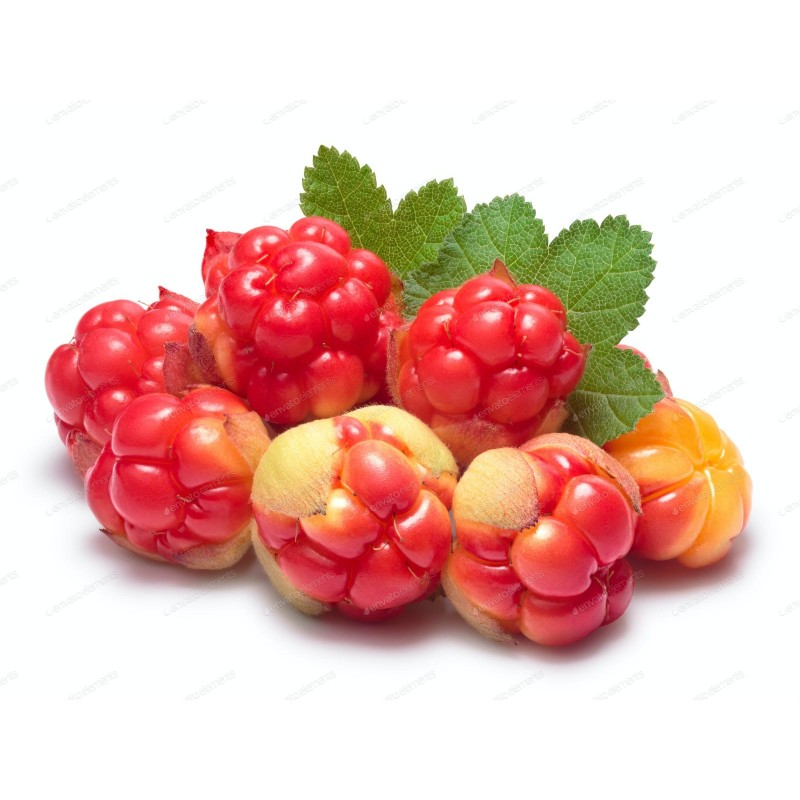
Cloudberry Seeds (Rubus chamaemorus)
Cloudberry Seeds (Rubus chamaemorus)
Price for Package of 5 seeds.
Rubus chamaemorus is a species of flowering plant in the rose family Rosaceae, native to cool temperate regions, alpine and arctic tundra and boreal forest. This herbaceous perennial produces
Cloudberry Seeds (Rubus chamaemorus)
Price for Package of 5 seeds.
Rubus chamaemorus is a species of flowering plant in the rose family Rosaceae, native to cool temperate regions, alpine and arctic tundra and boreal forest. This herbaceous perennial produces amber-colored edible fruit similar to the blackberry. English common names include cloudberry, nordic berry, bakeapple (in Newfoundland and Labrador), knotberry and knoutberry (in England), aqpik or low-bush salmonberry (in Alaska – not to be confused with salmonberry, Rubus spectabilis),[3] and averin or evron (in Scotland).
Description

Unlike most Rubus species, the cloudberry is dioecious, and fruit production by a female plant requires pollination from a male plant.[1]
The cloudberry grows to 10–25 cm (4–10 in) high.[1] The leaves alternate between having 5 and 7 soft, handlike lobes on straight, branchless stalks. After pollination, the white (sometimes reddish-tipped) flowers form raspberry-sized aggregate fruits which are more plentiful in wooded rather than sun-exposed habitats.[1] Consisting of between 5 and 25 drupelets, each fruit is initially pale red, ripening into an amber color in early autumn.
Distribution and ecology
In North America, cloudberries grow wild across Greenland, most of northern Canada, Alaska, northern Minnesota, New Hampshire, Maine, and New York.[1][5]Cloudberries are a circumpolar boreal plant, occurring naturally throughout the Northern Hemisphere from 78°N, south to about 55°N, and are scattered south to 44°N mainly in mountainous areas and moorlands.[1] In Europe, they grow in the Nordic countries, Baltic states and particularly in Poland.[1] They occur across northern Russia east towards the Pacific Ocean as far south as Japan.[1] Due to peatland drainage and peat exploitation, they are considered endangered[1] and are under legal protection in Germany's Weser and Elbe valleys, and at isolated sites in the English Pennines and Scottish Highlands. A single, fragile site exists in the Sperrin Mountains of Northern Ireland.[4]
Wide distribution occurs due to the excretion of the indigestible seeds by birds and mammals. Further distribution arises through its rhizomes, which are up to 10 m (33 ft) long and grow about 10–15 cm (3.9–5.9 in) below the soil surface, developing extensive and dense berry patches.[1] Cuttings of these taken in May or August are successful in producing a genetic clone of the parent plant.[6] The cloudberry grows in bogs, marshes, wet meadows, tundra and altitudes of 1,400 metres (4,600 ft) above sea level in Norway, requiring acidic ground (between 3.5 and 5 pH).[1]
Cloudberry leaves are food for caterpillars of several Lepidoptera species. The moth Coleophora thulea has no other known food plants. See also List of Lepidoptera that feed on Rubus.
Cultivation

Despite great demand as a delicacy (particularly in Sweden, Norway and Finland) the cloudberry is not widely cultivated and is primarily a wild plant. Wholesale prices vary widely based on the size of the yearly harvest, but cloudberries have gone for as much as €10/kg (in 2004).[7]
Since the middle of the 1990s, however, the species has formed part of a multinational research project. Beginning in 2002, selected cultivars have been available to farmers, notably 'Apolto' (male), 'Fjellgull' (female) and 'Fjordgull' (female). The cloudberry can be cultivated in Arctic areas where few other crops are possible, for example along the northern coast of Norway.
Uses


The ripe fruits are golden-yellow, soft and juicy, and are rich in vitamin C.[1] When eaten fresh, cloudberries have a distinctive tart taste. When over-ripe, they have a creamy texture somewhat like yogurt and a sweetened flavor. They are often made into jams, juices, tarts, and liqueurs. In Finland, the berries are eaten with heated leipäjuusto (a local cheese; the name translates to "bread-cheese"), as well as cream and sugar. In Sweden, cloudberries (hjortron) and cloudberry jam are used as a topping for ice cream, pancakes, and waffles. In Norway, they are often mixed with whipped cream and sugar to be served as a dessert called multekrem (cloudberry cream), as a jam or as an ingredient in homemade ice cream. Cloudberry yoghurt—molte- or multeyoughurt—is a supermarket item in Norway.[8]
In Newfoundland and Labrador, Canada, cloudberries are used to make "bakeapple pie" or jam. Arctic Yup'ik mix the berries with seal oil, reindeer or caribou fat (which is diced and made fluffy with seal oil) and sugar to make "Eskimo ice cream" or akutaq.[1] The recipes vary by region. Along the Yukon and Kuskokwim River areas, white fish (pike) along with shortening and sugar are used. The berries are an important traditional food resource for the Yup'ik.
Due to its high vitamin C content,[1] the berry is valued both by Nordic seafarers and Northern indigenous peoples. Its polyphenol content, including flavonoid compounds such as ellagic acid, appears to naturally preserve food preparations of the berries.[1] Cloudberries can be preserved in their own juice without added sugar, if stored cool.[9]
Extract of cloudberries is also used in cosmetics such as shower gels, hand creams and body lotions.
Alcoholic drinks
In Nordic countries, traditional liqueurs such as lakkalikööri (Finland) are made of cloudberry, having a strong taste and high sugar content. Cloudberry is used as a flavouring for making akvavit. In northeastern Quebec, a cloudberry liqueur known as chicoutai (aboriginal name) is made.[10]
Nutrients and phytochemicals
Cloudberries are rich in vitamin C and ellagic acid,[1] citric acid, malic acid, α-tocopherol, anthocyanins and the provitamin A carotenoid, β-carotene in contents which differ across regions of Finland due to sunlight exposure, rainfall or temperature.[11] The ellagitannins lambertianin C and sanguiin H-6 are also present.[12] Genotype of cloudberry variants may also affect polyphenol composition, particularly for ellagitannins, sanguiin H-6, anthocyanins and quercetin.
Polyphenol extracts from cloudberries have improved storage properties when microencapsulated using maltodextrin DE5-8.[14] At least 14 volatile compounds, including vanillin, account for the aroma of cloudberries.
Cultural references
The cloudberry appears on the Finnish version of the 2 euro coin.[16] The name of the hill Beinn nan Oighreag in Breadalbane in the Scottish Highlands means "Hill of the Cloudberries" in Scottish Gaelic.
Harvesting on public property
In some northern European countries such as Norway, a common use policy to non-wood forest products allows anyone to pick cloudberries on public property and eat them on location, but only local residents may transport them from that location and only ripe berries may be picked.[18][19][20] Since 1970 in Norway, while it has been illegal to pick unripe cloudberries, transporting ripe cloudberries from the harvest location is permitted in many counties.
| Organic Seeds ? | Organic Seeds |
|---|---|
| Organic/natural ? | Organic/Natural: Yes |
| Pretreatment of sowing ? | Soak in water before sowing: 24-48 h Stratification needed: Yes |
| Perennial ? | Perennial plant : Yes |
| Zbierane ręcznie nasiona? | Ręcznie zbierane nasiona |
| Resistant to cold and frost ? | Cold resistant: to −40 °C |
| Suitable for growing in flower pot ? | Suitable for pot: Yes |
| Plant height ? | Plant height 10 - 20 cm |


Chwilowo nie możesz polubić tej opinii
Zgłoś komentarz
Zgłoszenie wysłane
Twoje zgłoszenie nie może zostać wysłane
Napisz swoją opinię
Recenzja została wysłana
Twoja recenzja nie może być wysłana
🌍 Wysyłka na cały świat z UE
Wysyłamy zamówienia na cały świat z Unii Europejskiej za pośrednictwem poczty poleconej z potwierdzeniem odbioru.
📦 Śledzenie przesyłki
Aby śledzić przesyłkę, zaloguj się na swoje konto i przejdź do sekcji Historia zamówień > Szczegóły, gdzie znajdziesz numer śledzenia.
Śledzenie międzynarodowe: 17Track
Dla numerów takich jak RGxxxxxxHR: Śledzenie Posta.hr
🕒 Uwaga: informacje o śledzeniu pojawią się dopiero po 24 godzinach od nadania.
⚠️ Ważne uwagi
Płatność za pobraniem nie jest możliwa.
Sprawdzaj folder SPAM / Niechciane w swojej skrzynce e-mail, aby nie przegapić powiadomień.
Korzystaj wyłącznie z formularza kontaktowego na naszej stronie.
Wiadomości wysłane bezpośrednio na e-mail mogą nie zostać odebrane.
📱 Numer telefonu wymagany
Podczas składania zamówienia koniecznie podaj numer telefonu komórkowego z kodem kraju.
Przykład: +48 123 456 789
🚚 Warunki dostawy
Dla przesyłek poleconych wymagany jest podpis odbiorcy (osoby, do której adresowana jest paczka).
Nie zamawiaj, jeśli:
chcesz, aby paczka została dostarczona do skrzynki pocztowej
nie będzie Cię w domu w czasie doręczenia
chcesz, by paczka została zostawiona u sąsiada (❌ to niemożliwe)
📬 Podanie adresu skrzynki pocztowej oznacza utratę prawa do zwrotu w razie zagubienia przesyłki.
↩️ Zwrot paczki i ponowna wysyłka
Jeśli paczka zostanie zwrócona do nas z jakiegokolwiek powodu:
Pokrywasz koszt zwrotu 2 €
Oraz koszt ponownego nadania
⏱ Opóźnienia i śledzenie
Jeśli śledzenie wskazuje, że paczka wciąż jest „u nadawcy”, oznacza to, że jest w transporcie.
Skontaktuj się z lokalnym urzędem pocztowym, podając numer śledzenia.
Nie jesteśmy firmą kurierską – nie mamy możliwości monitorowania przesyłek za klientów.
Nie ponosimy odpowiedzialności za czas dostawy.
🔍 Reklamację zagubionej paczki możemy rozpocząć dopiero po 30 dniach od daty wysyłki.
✈️ Opcje wysyłki
| Typ wysyłki | Czas realizacji | Ubezpieczenie | Możliwe opóźnienie | Uwagi |
|---|---|---|---|---|
| Standardowa | 7–10 dni roboczych | ❌ | 7–14 dni | Najtańsza opcja |
| Priorytetowa | 1–7 dni roboczych | ❌ | 3–10 dni | Zamówienie przetwarzane priorytetowo, ale nie szybciej |
| Ubezpieczona | 1–7 dni roboczych | ✅ | 3–10 dni | Zwrot kosztów w przypadku zagubienia paczki (do 150 €) |
🕒 Szacowany czas dostawy:
W obrębie Unii Europejskiej: 3–20 dni roboczych
Globalnie: 5–30 dni roboczych
Przykładowe dostawy do USA: 27, 22, 19, 17, 13 dni
💳 Metody płatności
💶 Przelew bankowy (SEPA / IBAN / SWIFT-BIC)
W opisie przelewu koniecznie podaj numer zamówienia (np. SGS-19811702).
Brak opisu może spowodować opóźnienie lub anulowanie zamówienia.
Jeśli płatność nie zostanie zaksięgowana w ciągu 7 dni – zamówienie zostanie anulowane.
🅿️ PayPal
Akceptujemy płatności wyłącznie w euro.
Ustaw walutę na euro podczas płatności.
💳 Karta płatnicza
Płatności kartą odbywają się przez naszą stronę: Exotic Seeds Store
Akceptujemy: Visa, MasterCard, American Express, Diners Club, UnionPay, JCB, Discover i inne.
💡 Klient ponosi wszelkie opłaty transakcyjne.
Aby przyspieszyć realizację zamówienia, prześlij potwierdzenie przelewu.
📅 Dodatkowe uwagi
Nie przetwarzamy zamówień ani nie wysyłamy paczek w soboty i niedziele.
Przed złożeniem zamówienia sprawdź ogłoszenia na naszej stronie (np. przerwy świąteczne lub specjalne warunki).
📫 Uwaga:
Nie wysyłaj wiadomości e-mail. Używaj wyłącznie formularza kontaktowego dostępnego na naszej stronie.
Related Products

















